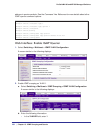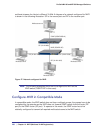
Chapter 14. MVR (Multicast VLAN Registration) | 255
14
14. MVR (Multicast VLAN Registration)
This chapter provides the following examples:
• Configure MVR in Compatible Mode
• Configure MVR in Dynamic Mode
The IGMP Layer 3 protocol is widely used for IPv4 network multicasting. In Layer 2 networks,
the IGMP protocol uses resources inefficiently. For example, a Layer 2 switch multicasts
traffic to all ports even if there are receivers connected to only a few ports.
To fix this problem, the IGMP Snooping protocol was developed. But the problem reappears
when receivers are in different VLANs. Multicast VLAN Registration (MVR) is intended to
solve the problem of receivers in different VLANs. It uses a dedicated manually configured
VLAN, called the multicast VLAN, to forward multicast traffic over Layer 2 network in
conjunction with IGMP snooping.
MVR, like the IGMP Snooping protocol, allows a Layer 2 switch to snoop on the IGMP
control protocol. Both protocols operate independently of each other. Both protocols can be
enabled on the switch interfaces at the same time. In such a case, MVR listens to the join
and report messages only for groups configured statically. All other groups are managed by
IGMP snooping.
There are two types of MVR ports: source and receiver.
• The source port is the port to which the multicast traffic flows using the multicast VLAN.
• The receiver port is the port where a listening host is connected to the switch. It can
utilize any (or no) VLAN, except the multicast VLAN. This implies that the MVR switch
performs VLAN tag substitution from the multicast VLAN source port to the VLAN tag
used by the receiver port.
The Multicast VLAN is the VLAN that is configured in the specific network for MVR purposes.
It has to be manually specified by the operator for all source ports in the network. It is a
VLAN that is used to transfer multicast traffic over the network to avoid duplication of


















